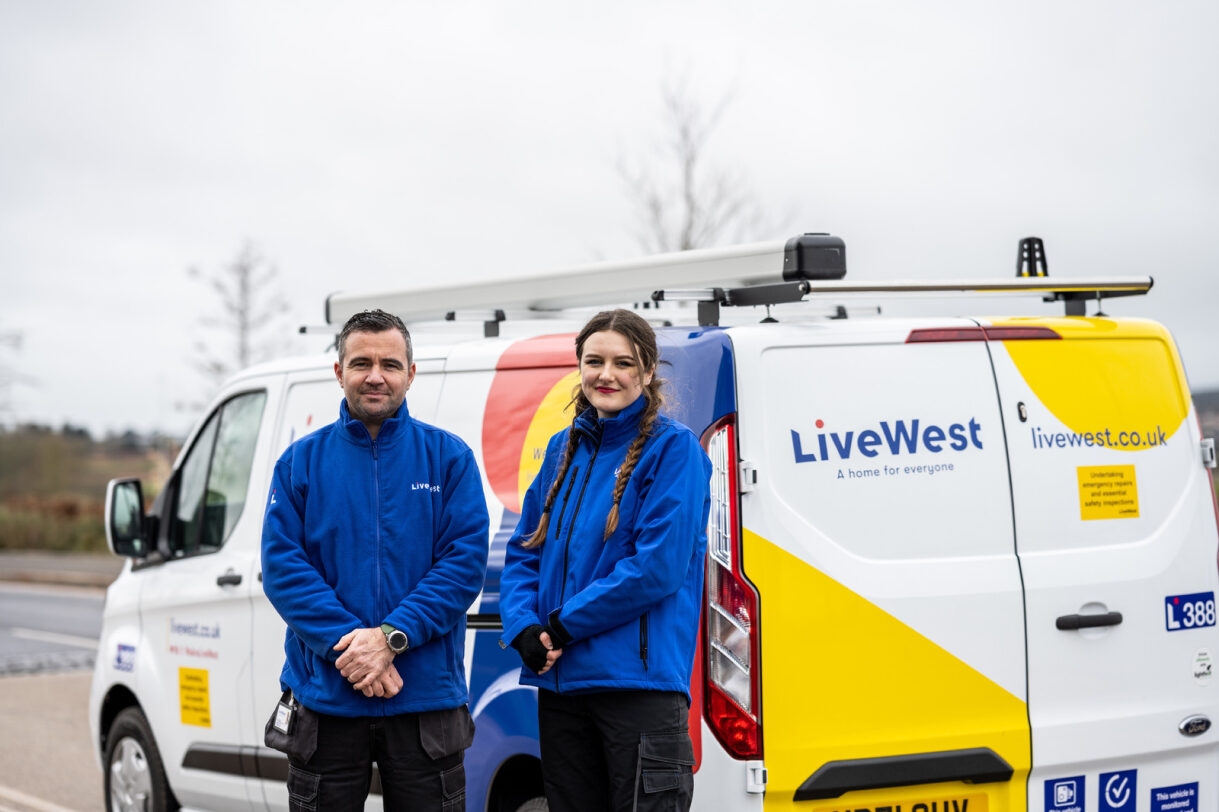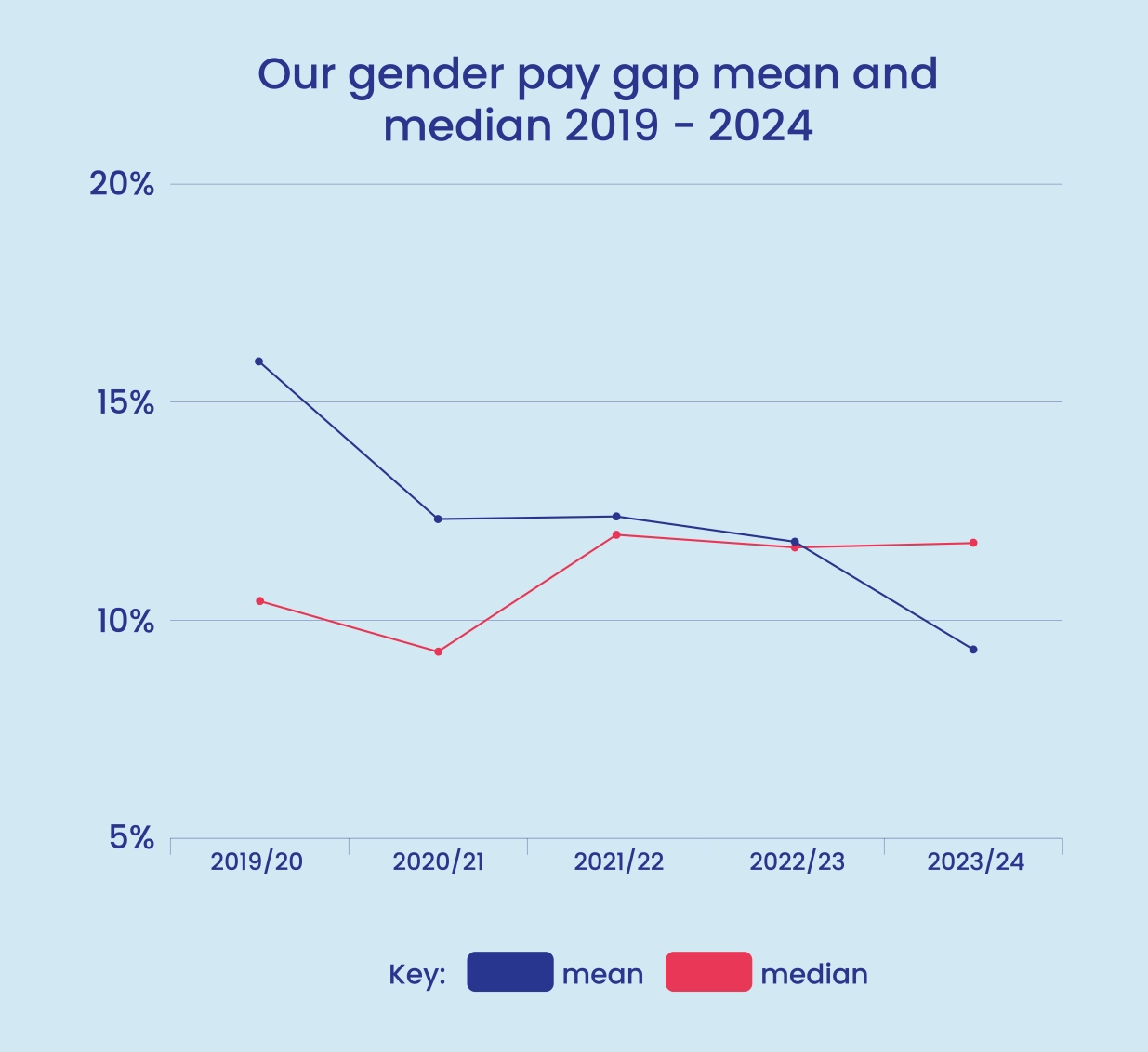
We live in a world that is not always fair, where privilege assists some, and the lack of it can hold others back. As part of our equality, diversity and inclusion plans, we have agreed to take proactive steps to correct any imbalances and provide an equal place for everyone to work.
We are committed to attracting a more diverse workforce by ensuring our colleagues are gender balanced and fairly paid. Having a diverse mix of talented people in our business leads to innovation, development and engagement, which is fundamental to our success.
We recognise this will take time and focus, but we want to ensure that there are no potential barriers to the successful development and progression of women, or any minority group at LiveWest.
On this page:
What is gender pay gap reporting?
The distribution of men and women in our workforce
How we make additional payments
What is gender pay gap reporting?
Gender pay gap reporting is about the difference between the average pay of men and women working here. It isn’t the same as equal pay; which is a legal obligation to ensure that men and women doing the same or similar jobs are paid the same, we have embedded this in our job evaluation processes.
Note: In the tables and graphs below, the year specified, for example, 2023/24, relates to data from the financial year ending April 4 2023.
Where are we now?
We have made progress in reducing the pay gap in a number of areas over the last five years, as we illustrate in this report. We are confident the actions we are taking will support us in achieving our goal of reducing the gap further.

The distribution of women and men in our workforce
Overall, the distribution of women and men we employ varies across the types and seniority of roles. When we divide our employee team into four quarters (or ‘quartiles’) according to how much they earn, the proportion of men and women within each quartile is shown in Table 1.
As in many organisations and society as a whole, we have a higher number of women in lower paid roles, and a higher proportion of men in higher paid roles.
As table 1 demonstrates, this year we have seen small changes in Q2 and Q3, with a larger proportion of men. This has mainly been as a result of insourcing repairs teams - these teams have a higher proportion of men, although we are recruiting more women to our trades teams, through our ongoing women in trades programme.
Table 1: The distribution of men and women in our workforce by quartile
|
2022/23 |
2023/24 |
||||
|---|---|---|---|---|---|
People |
% |
People |
% | ||
| Q1* |
Male |
114 | 30% | 130 | 31% |
Female |
265 | 70% | 286 | 69% | |
| Q2* |
Male |
194 | 51% | 236 | 57% |
Female |
185 | 49% | 180 | 43% | |
| Q3* |
Male |
212 | 56% | 262 | 63% |
Female |
167 | 44% | 154 | 37% | |
| Q4* |
Male |
207 | 54% | 222 | 53% |
Female |
173 | 46% | 194 | 47% | |
Total |
1,517 | 1,664 | |||
*Key: Q1 = Quartile 1 (lower) - Q2 = Quartile 2 (lower middle) - Q3 = Quartile 3 (upper middle) - Q4 = Quartile 4 (upper)
*We divide our employee team into four quarters (or ‘quartiles’) according to how much they earn.
What is the gender pay gap?
The gender pay gap is the difference between the average hourly earnings for men in an organisation and the average hourly earnings for women. For example, a 10% gender pay gap shows that women earn 10% less per hour, on average, than men. A negative -10% gender pay gap shows that women earn 10% more, on average than men.
The average is calculated as both mean and median. Mean earnings are calculated by adding up all hourly earnings and dividing them by the number of employees. Median earnings come from ranking all earnings from lowest to highest and identifying the employee in the middle of the list.
The mean (simple average) is preferred to the median as it gives a better measure of pay across the organisation. We are pleased to share that our mean gender pay gap has fallen consistently over the last five years, as shown in the graph (Table 2). Since 2018/19, we have reduced our gender pay gap by just over 7%.
Table 2

How we make additional payments
As Table 3 highlights, we have seen a dramatic reduction in overall additional payments in 2023/24. This is because during the last year we did not pay an organisational bonus. However, we continued to pay long service awards and made thank you payments.
These factors have seen a significant shift in the median and mean gaps to become negative figures, as demonstrated in Table 4.
Table 3: Proportion receiving additional payments
2022/23 | 2023/24 | |
|---|---|---|
| Male | 89.97% | 13.37% |
| Female | 92.41% | 11.36% |
Table 4: Additional payments gap
2022/23 | 2023/24 | |
|---|---|---|
| Median | 0% | -33.33% |
| Mean | 14.60% | -60.12% |
Steps we have already taken
We have continued to publish our Equality, Diversity and Inclusion (EDI) annual report, providing an overview of our progress towards meeting our EDI strategy objectives.
Some steps we have taken this year to achieve our vision of building and sustaining a representative workforce include:
Improving our approach to family leave
This year, our Sexuality And Gender Equality (SAGE) group worked to review and improve our family leave policy. We have made it gender-neutral to better reflect the diversity of our workforce. We have also removed the limit on how many appointments both parents can attend, as each pregnancy is unique.
Encouraging more women into trades
We continue to encourage more women to pursue a career in trades and have welcomed even more women in to our In-House Maintenance Service team, increasing the percentage of women in the team from 1.6% in March 2021 to 4.2% in 2023.
Listening to our colleagues to learn how we can do better
Each year we survey our colleagues to find out how we are performing against our EDI objectives. Over 1,100 (67%) colleagues responded to our survey with over 88% of those telling us LiveWest is an employer that embraces and celebrates diversity.

Where we want to be
Our vision is to build and sustain a representative workforce across all areas of our business, with a diverse leadership team that reflects our commitment to equality, diversity and inclusion.
Key elements of our vision
So, what are we doing about our pay gap?
The best person will always get the job at LiveWest, however, when appropriate we have and will take positive action to attract a more diverse talent pool of applicants.
We will grow our own talent by creating development opportunities, with the aim to address where we have underrepresentation in certain teams.
We will continue to support new and existing colleagues who wish to change their careers with our award-winning apprenticeship program, offering colleagues greater career opportunities.
Our hybrid working practices are ever evolving to help colleagues to balance their home lives and health and wellbeing with work, and support those who don’t work the traditional ’9-5 in the office’ model to have a career.
